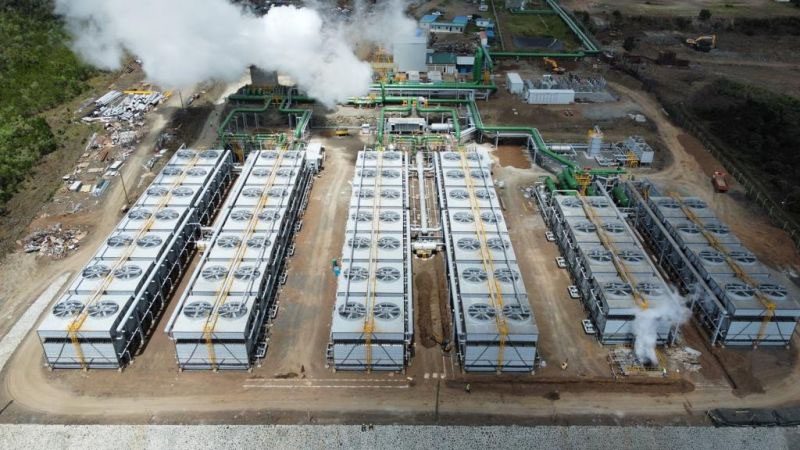Green Light for Second Geothermal Power Project in Kenya’s Menengai Field
Independent power company Globeleq and Kenya’s state-owned Geothermal Development Co. (GDC) are readying to launch construction of the 35-MW Menengai II geothermal project in Kenya’s Nakuru County. When completed in 2025, the power project will become the second to come online in the wider Menengai complex in Kenya’s geothermal-rich Rift Valley region.
Globeleq and GDC on Dec. 28, 2023, announced the financial close of the $117 million project. The milestone now paves the way for the partners to kick off construction activities in the coming weeks, spearheaded by engineering, procurement, and construction contractor (EPC) Toyota Tsusho Corp. (TTC) and TTC’s fully-owned subsidiary CFAO Kenya.
Menengai: Kenya’s Newest Large-Scale Field After Olkaria
The project marks more progress for the burgeoning geothermal sector in Kenya. Menengai, a high-temperature geothermal system that comprises the Menengai caldera, is one of several geothermal fields under development in Kenya’s Rift Valley region. For decades, the East African country has primarily focused development on only one large-scale geothermal power complex—the Olkaria Geothermal Project, which is situated within Hell’s Gate National Park near the scenic Lake Naivasha in Nakuru County. Five of the six geothermal power stations at the site are owned by KenGen, and one is owned by Ormat Technologies. KenGen’s plants have a combined capacity of 799 GW.
GDC, which was formed in 2008 as a state-owned special purpose vehicle (SPV) to accelerate the development of geothermal resources in Kenya, began developing the Menengai complex in 2009. (Today, the company is a 100% state corporation operating under the Ministry of Energy and Petroleum.) While GDC says the Menengai complex harbors a potential of 1,600 MW, its long-term goal is to develop 465 MW of geothermal steam equivalent.
GDC envisions development in five phases. The first 105-MW phase (Menengai Phase 1), assumes a “steam sales business model,” where GDC “supplies steam to the power plants for conversion to electricity,” GDC says. The company utilizes a steam gathering system (SGS)—a “mega piping system” spanning 25 kilometers—to collect and deliver steam from steam fields to the geothermal power plants. As of 2023, 53 wells with a potential of 169 MW were drilled, GDC notes.
Sosian Menengai Geothermal Power Limited (SMGPL), a domestic IPP, began operating the first project in the field, the 35-MW Menengai III, in August 2023. Energy and Petroleum Cabinet Secretary Davis Chirchir in August told national newspaper The Standard the plant is “discharging at 6.9 U.S. cents (about Sh9.6 per unit), which is competitive.”

Monetizing Steam Resources
Globeleq is owned 70% by British International Investment, a UK government development institution, and 30% by Norfund, an Africa-focused power developer, owner, and operator. The company acquired a controlling stake in QPEA in 2021. The third project, Orpower Twenty Two, is owned by China’s Kaishan Group, an air compressor maker that is transitioning into a renewable energy company. Kaishan served as EPC for Sosian’s Menengai III project, which is now online.
According to Kaishan, the Sosian-Menengai geothermal power station is powered by Kaishan modular power plants, two steam screw expanders, and three wet steam Organic Rankine Cycle (ORC) modular power plants. “It does not need to use the steam ejector and vacuum pump of the traditional central power station to separate non-condensable gases, thereby reducing the parasitic load of the power station and improving its efficiency,” the company said in a briefing related to a presentation at the 2023 World Geothermal Congress in Beijing in September.
Globeleq in December said that when Menengai II reaches commercial operations in 2025, it will deliver “clean, reliable, and affordable baseload power to the national grid and enable GDC to monetize the available steam resources from the Menengai steam field.” GDC will supply steam to the project by GDC under a 25-year project implementation and steam supply agreement. Globeleq will operate and maintain the power plant once it reaches commercial operations, selling its power to national distribution company Kenya Power under a 25-year power purchase agreement.
“The financial close reached by Globeleq and its partners is a great milestone for the geothermal sector in Kenya,” noted Paul Ngugi, GDC managing director and CEO. “It affords the country another opportunity to develop 35 MW more of clean, affordable, and reliable power.”
The Menengai geothermal project is of “strategic national value, especially at this critical moment when Kenya is determined to decarbonize its economy,” he added. “The available geothermal resource in Menengai is plentiful, and at GDC, we are happy that we made the project bankable for investor entry.”
—Sonal Patel is a POWER senior associate editor (@sonalcpatel, @POWERmagazine).